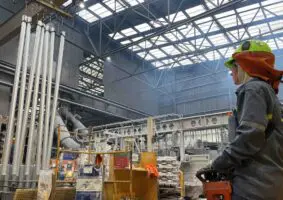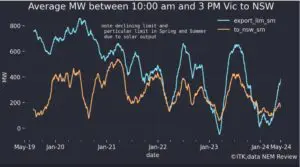In part 1 of this series we looked at some characteristics of the National Electricity Market and the volatility of wind and solar, and stated that the foundation stone of decarbonisation has to be an economy-wide carbon tax, because electricity is only about 36 per cent of Australian carbon emissions.
This time around we look at a couple of other attempts at modelling out high renewable penetration in Australia and see what’s changed. The University of NSW and University of Sydney believe it can mostly be done with wind and solar PV, with some minor help from other technologies.
None of the studies assume much of a role for lithium-ion battery storage and, as such, to my way of thinking, they are all a bit incomplete. The most thorough model is the AEMO study, but it assumed reliance on technologies that are nowhere near ready for prime time, and as every other study shows, aren’t necessary.
In part 3 we will try and look at the AEMO daily supply curves but use our own technology assumptions to develop a different supply mix. Part 3 may take a while.
Literature review by “Centre for Energy and Environmental Markets” UNSW
Fortunately, we don’t have to do our own literature survey as the UNSW has done one for us. This link is to a working paper from as recently as March 2016. Great minds think alike!
This summary of literature concluded that 100% renewables is possible, and would likely involve wind supplying 80 per cent of the energy. The generation cost of electricity would have a weighted average of between $100-$140/MWh (around last week’s pool prices). See Fig 1 below.
This paper was typical of most such studies, in that batteries are dismissed early on in the piece. The study had this to say on storage:
“Do we need novel energy storage systems such as batteries?
Modelling to date consistently suggests that novel battery energy storage are not required to reliably operate a 100% renewable electricity system. There is sufficient geographical diversity in the wind and PV generation in Australia, sufficient firm renewable capacity available, and a host of other lower cost means for achieving system flexibility, that an affordable, reliable electricity system can be constructed without any need for electrochemical batteries at all.
However, if battery costs continue to fall, it may become cost effective to install some battery storage, particularly in cases where this can defer investment in distribution networks.
Batteries are likely to be important for facilitating larger quantities of PV generation (beyond those illustrated in Figure 5), since PV only generates during a relatively narrow window of time during the middle of the day [18]. This means that PV generation can tend to “saturate” at a level of 8-15 GW in the NEM, if batteries are not present [19, 20, 21, 22]. “

We include one graph from their working paper to indicate some of the studies that have already been done.
The 2012/2013 AEMO study
It was only five years ago, in 2011, that the government of the day announced its clean energy plan. That plan ultimately handed $750 million of only partly recovered compensation to brown coal generators in Victoria, left us with the CEFC and ARENA, and some nostalgia for what might and should still be a sensible policy.
The government-commissioned AEMO “100% renewables study”, as with all such studies, is only as useful as the assumptions it makes. Reading this work four years later, the main points to strike home are:
- Total capital cost at the time was estimated at $212-$332 billion. We will return to this later but we think that from today’s perspective that’s a very pessimistic assumption.
- The operational issues appeared manageable. Think about it. That’s a pretty encouraging comment from the AEMO
- More capacity relative to maximum demand was likely to be needed. The AEMO estimated that capacity more than 2X maximum demand would be needed.
AEMO methods outcomes
The AEMO report employed two methods of “least cost” supply, probabilistic modelling and time-sequential. The probabilistic model used Monte Carlo (random numbers) to generate 500 random days of supply and renewable output with hourly profiles. It was a requirement that current NEM reliability be maintained.
The point about this modelling is that AEMO had the demand profiles and took assumptions about supply “profiles”. Both Summer and Winter outcomes were modelled. The Chart below is reproduced from the AEMO study. Supply was modelled across 43 separate regions of the NEM. In other words it was a thorough model:

AEMO intended this graph to show load shapes, but what we see is that the baseload supply was coming from about 10GW of geothermal, about 4-5GW of biomass (burning wood and sugarcane), 2-3GW of wave energy and a small amount of onshore wind. In short, the vast amount of energy was being supplied by technologies that were not then, and are not today, even technically proven (bio mass excepted) let alone economically proven. Shoulder demand was met by CSP with storage, biogas and hydro (with pumped storage).
No rational person could commit to such a system today. And we don’t think it’s necessary. Far larger chunks of demand can be supplied by wind and solar. Whereas AEMO, using cost assumptions largely developed by others, ignored battery storage, to us it seems that battery storage both for power and for energy is a far more viable technology. Not only that, examples from around the world and in Australia, for instance the Coober Pedy and King Island plants, don’t use any of the AEMO technologies other than wind and PV.
The market is speaking and Lithium storage is happening
Globally, there are about 1.2GW of storage already installed, with another 1.6GW in the planning stage. AES in the USA is among the leading global suppliers of storage solutions to utilities. Its larger projects are mostly in the 20-40MW scale at the moment, with the purchaser using the technology for frequency control as much as energy storage.
AES states that by 2024 global manufacturing capability of grid ready batteries will exceed 130GW (per year). Remember global PV installations are only about 50-60GW per year right now.
Our single biggest point here is that lithium storage is a technology that is available today, where global volumes are going to be growing at 20-100 per cent a year for a decade or more, and where unit costs are likely to fall 15-20 per cent per year for that same decade.
Speaking of the cost of lithium storage the best price point I have seen yet is that LG is selling cells/batteries to General Motors for next year’s Chevvy Bolt for – wait for it – $US145/kWh. A discussion of exactly what this price refers to can be found here.
We did some calculations around this and it suggests household storage could be done for $A55/MWh. I’ve ignored round-trip efficiency losses and each and all my assumptions can be questioned, but the bottom line is when the cells are at $145/kWh from LG many things are possible:

Geothermal, currently just a pipe dream
By contrast geothermal plants are technologically unproven, economically unproven, require in Australia vast amounts of transmission support and thus seem like a bad bet. Maybe someone will prove this wrong one day, but not in the time-frame required to avoid the 2°C by 2035 scenario.
Wave energy not ready for prime time
Wave energy is a small bit further down the track and in theory might be located closer to load centres. ASX listed Carnegie Wave owns, according to its presentation, the only operational wave farm project in the world, but we can’t see even 1MW operating by 2018. Carnegie, itself, has turned part of its focus to microgrids incorporating solar and lithium-ion battery storage. The concept is these microgrids will be available to, say, Pacific Islands and will be backwards compatible with the wave energy when its ready.
Concentrating Solar, not my choice but might be a goer
Concentrating solar plants with storage remain the enigma of the renewable world. By their nature they are large utility-scale projects and, as such, monitoring cost and performance is a case by case exercise. Generally its believed that they can produce power at $US200/MWh. The poster child for the industry is possibly the Crescent Dunes project in Nevada, which had a budgeted and we think actual cost of around $US1 billion for a 125MW plant with 10 hours storage. This project broke ground in 2011 and became operational in November 2015, although originally scheduled for 2013.
Best monthly production so far was 9.1GWh in February 2016. A 40 per cent capacity factor should mean about 36GWh per month so commissioning is clearly going very slowly. The project has a contract to sell electricity for $US135/MWh, but we don’t see how it can earn its cost of capital at that price. The Ivanpah project in the US (which does not include storage) has been operating longer but its capacity factor is significantly lower than modelled and the project is at some risk of not meeting its contractual output commitments, according to some media reports.
Spain, as of 2013, had 2.3GW of CSP installed, mostly without storage, and would have trouble delivering dispatchable power, month by month.
However, recent plants in South Africa and Chile may be doing better. CSP plants can apparently easily be impacted by dust and, as we understand it, require constant direct sunlight. It seems reasonable that this technology is still very early in its life cycle. However, by its nature big utility plants like this have less opportunities to scale up and come down the learning curve for costs when compared with PV and lithium batteries.
That said, the promise remains that CSP can produce on demand power for around $250-300/MWh. The study that looked at this in the most detail is here.
David Leitch is principal of ITK. He was formerly a Utility Analyst for leading investment banks over the past 30 years. The views expressed are his own. Please note our new section, Energy Markets, which will include analysis from Leitch on the energy markets and broader energy issues. And also note our live generation widget, and the APVI solar contribution.










